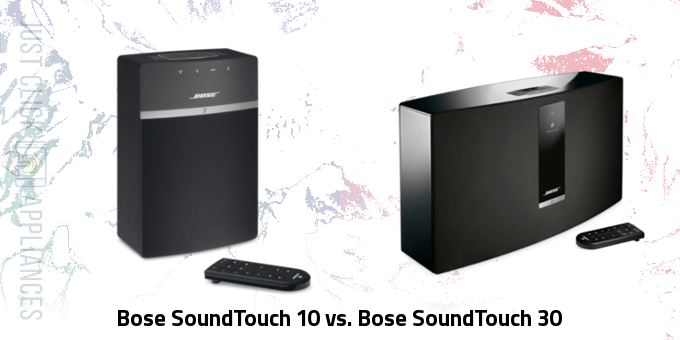The Bose SoundTouch 10 vs. 30 battle may be a closer race than you’d think. While the SoundTouch 30 seems to have some of the best features across the board, the SoundTouch 10 may give its big brother a run for its money with the ability to pair two great speakers together.
We dive into the differences between these two smart speakers below so you can decide which Bose product is right for you.
Bose SoundTouch 10 vs. 30 — Differences
Difference #1: Mono/Stereo Output – The Bose Soundtouch 10 uses Mono sound while the Soundtouch 30 uses multiple audio channels for stereo sound.
The Soundtouch 10 can be expanded, however, with an identical model to create a stereo pair for a more well-rounded sound.
Difference #2: Stereo Pair Option – The Soundtouch 30 honestly outclasses the Soundtouch 10 in most every way, but the battle gets a lot closer when you pair two 10’s together — allowing each speaker to form one of the two stereo audio channels.
The Soundtouch 30, unfortunately, doesn’t offer the option to pair with another speaker. This isn’t the end of the world since it already has stereo sound by default, but it’s definitely a limitation worth noting.
Difference #3: Sound Quality – There is a significant disparity in terms of sound quality when comparing the Soundtouch 10 and 30. The 10 produces excellent audio considering that it only has a single speaker, but it can’t compare with the 2 speakers that power the Soundtouch 30. A woofer included with the 30 also makes the bass levels much more impressive and elevates the speaker to a level where the 10 just can’t compete.
Pairing two speakers helps close the gap between the Soundtouch 10 and 30, but we feel that the latter is the best choice of audio quality is a major concern.
Difference #4: Ethernet Port – In situations where WiFi signals may not be the best, you can hook up your SoundTouch 30 directly to the router via the Ethernet port.
The SoundTouch 10 does not have a port, forcing you to rely on WiFi or Bluetooth for audio transmission.
Difference #5: OLED Screen – The 4 LEDs on the SoundTouch 10 give you some basic information about the speaker and its current status, but that can’t really compare with the OLED screen featured on the SoundTouch 30. With a display regarding the song, artist, station, and connectivity, you’re getting much more info from the 30 than you are from the 10.
Difference #6: Design – Perhaps the most notable difference when first taking a look at the SoundTouch 10 and 30 is the huge disparity in size.
The Soundtouch 10 is a compact speaker that weighs less than 3 pounds, while the SoundTouch 30 is a monster of a speaker at nearly 26 pounds.
The only real similarity in terms of design when comparing the two products is that they are both available in a black or white finish.
If you’re looking for a speaker that can fit neatly on a shelf, you’ll probably be better suited with the Soundtouch 10. Backing up the large size of the 30 is impressive audio and some nifty features, however, so you might want to find a place for what may be the superior speaker.
Bose SoundTouch 10 vs. 30 — Comparison Chart
| Bose SoundTouch 10 | Bose SoundTouch 30 | |
|---|---|---|
| Mono Output | Yes | No |
| Stereo Output | No | Yes |
| Stereo Pair w/ Other Speaker | Yes | No |
| Drivers/Speakers | 1 | 2 |
| Woofer | No | 1 |
| Audio line-in | Yes | Yes |
| Connect to TV | Via AUX Cord | Via AUX Cord |
| Has its Own Remote | Yes | Yes |
| Voice Control over Amazon Alexa | Yes | Yes |
| Voice Control Over Siri | No | No |
| Voice Control Over Google Assistant | Via line-in port | Via line-in port |
| Amazon Alexa Built-In | No | No |
| Set Up Over WiFi | Yes | Yes |
| Humidity Resistant | No | No |
| WiFi | 802.11 b/g/n, 2.4 and 5Ghz | 802.11 b/g/n, 2.4 and 5Ghz |
| Bluetooth | Yes | Yes |
| Ethernet Port | No | 1 |
| On-Device Control | Button Control | Button Control |
| One App Control | Yes | Yes |
| IR Control | Yes | Yes |
| Wall Mount | Available | Available |
| Extend to 5.1 | No | No |
| Size | Small | Big |
| Dimensions | 8.34 x 5.56 x 3.43″ (212 x 141 x 87 mm) |
9.7 x 17.1 x 7.1″ (246 x 434 x 180 mm) |
| Weight | 2.89 lbs (1.31 kg) | 25.75 lbs (11.68 kg) |
| Product finish | White/Black | White/Black |
Bose SoundTouch 10 vs. 30 — Things in Common
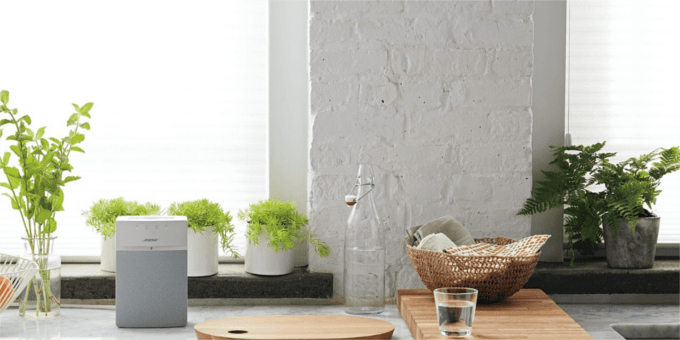
Audio line-in – For when you need to play music over an auxiliary cable rather than streamed over WiFi, the audio line-in featured on the Bose Soundtouch 10 and 30 gives you the ability to use your speakers on non-internet-connected devices. The line-in also gives you the ability to use utilities like Google Assistant — a feature we talk about in further detail below.
Comes with Remote – When your phone isn’t handy and you can’t use the physical buttons present on the device, the included remote control lets you manage all major functions from the comfort of your couch.
Voice Control over Amazon Alexa – The smart speaker functionality on the Bose Soundtouch 10 and 30 really comes to life when enabled by Amazon Alexa. Just pair your speaker with an Echo and Echo dot and control your music with simple voice commands.
Voice Control Over Google Assistant – Because of the audio line-in, you can take advantage of a Google Home device in order to control your speakers. This feature does not come naturally and takes up the auxiliary plug, but it’s a viable option for those tied to the Google ecosystem and would rather not buy an Alexa-enabled device.
Set Up Over WiFi – Installation and setup of the Soundtouch 10 and 30 is a breeze with their built-in support for 802.11 b/g/n 2.4 and 5Ghz connections. Setting up your speakers through an app lets you get the music playing more quickly and without any additional hassle.
Bluetooth Streaming – While most people will likely stream most of their content over WiFi, the Bose Soundtouch 10 and 30 also support Bluetooth streaming. This is the perfect option for when your WiFi is spotty or you’d like to share audio directly from an app to the Soundtouch device.
On-Device Control – Both the Soundtouch 10 and 30 have options for on-device control, allowing you to adjust the volume or skip tracks just by pressing a button on the speaker itself.
SoundTouch App – The Soundtouch app is your gateway for content on both smart speakers. With streaming partners like Spotify, Pandora, and Amazon all accessible through a single app, you’ll be able to find top tracks with a quick search rather than cycling through different programs. Having all of your content in one hub allows you to stream music that is stored on your phone while taking advantage of the huge catalog that these streaming services offer.
Flexible Mount Options – The Soundtouch 10 and 30 both have multiple options for installation. Whether you’re setting your speaker down on a shelf or mounting it to your wall, there’s bound to be a solution that works for you and your home.
Bose SoundTouch 10 and 30 Integration
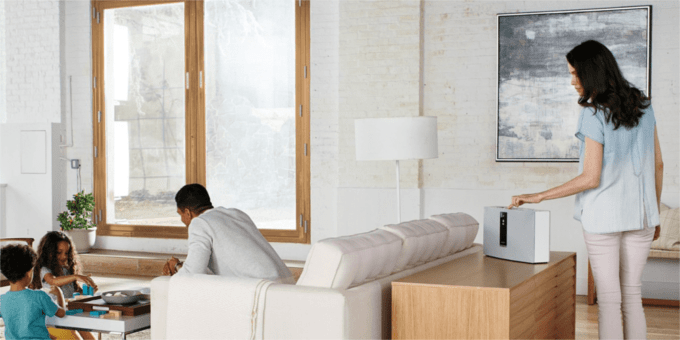
While the integration with smart home systems may be a little less robust than you’d see with products like the Sonos PLAY:5, both the Bose SoundTouch 10 and 30 offer support for SmartThings — one of the most popular home automation systems.
Additionally, should you choose to fill your home with Bose products, these speakers will work together in order to play the same music across your entire home or isolate the songs to specific areas. This feature allows you complete control over where you hear audio, and combined with a central smart home hub you’ll have the ultimate in customizability at your fingertips.
Bose SoundTouch 10 and 30 Accessories
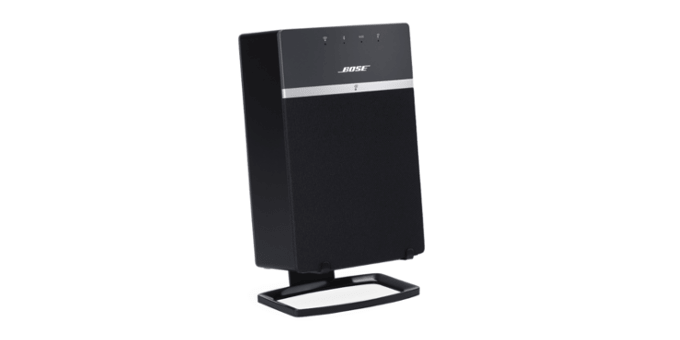
When you make the decision to buy either the SoundTouch 10 or SoundTouch 30, you may want to take advantage of some additional accessories in order to make installation a breeze.
The SoundTouch 10 wall and stand mounts allow you to choose exactly how your smart speaker fits into the room.
The 30 is even more customizable, with an optional stand mount, pouch bag for easy transportation, and a walnut wood cover for an even more attractive aesthetic.
In addition to these practical accessories, you may want to purchase an Echo Dot so you can take advantage of the convenience of Alexa voice controls.
Bose SoundTouch 10 vs. 30 — Our Thoughts
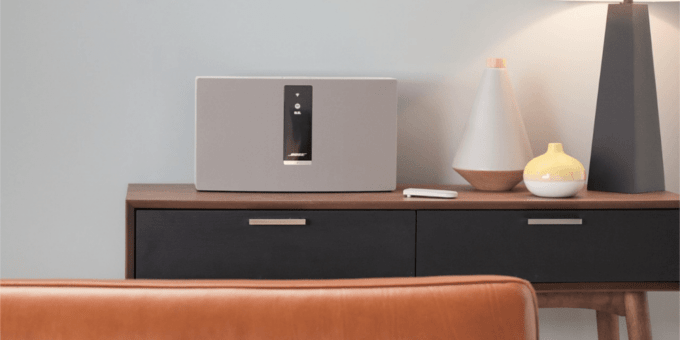
At the end of the day, we’d likely recommend the SoundTouch 30 over the 10, as it is clearly superior in a 1:1 comparison. With that said, the decision becomes a little bit more difficult if you compare dual SoundTouch 10 speakers versus a singular SoundTouch 30.
Despite double speakers closing the gap, we feel that a single SoundTouch 30 remains a superior buy. If you’re not tied to the Bose brand, however, there are other options out there. We compare the Bose SoundTouch 30 vs. Sonos PLAY:5 in order to discern which brand is the better buy, and the results may surprise you!
Last update on 2024-04-25 at 12:07 / Affiliate links / Images from Amazon Product Advertising API
